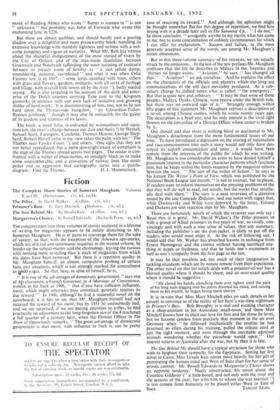"On Thames' Broad Aged Back"
IT is a nice point who has the more exacting task, the chronicler or the topographer of Thames, the one in his choice of what to leave out and put in, the other in how to present a readable account of a subject bristling with perplexities and complexities. Mr. Roll has exceptional qualifications for his formidable theme. He is a fresh- water navigator of wide experience, a countryman with an individual style of his own and an engineer by training who can write with authority on the construction of flash weirs, pound locks, cuts, culverts, wharfs, bridges and river-craft, together with the ways of watermen, It is no mean advantage to the reader that he has travelled the navigable reaches of Thames, apart from London River, in his own narrow boat.
As for the historical issue, it was perhaps the wisest course to follow his own predilections and ignore what was of small per- sonal interest to him. We may wonder why he has so little to say about Strawberry Hill, considering that it is the point of junction between the jurisdictions of the Port of London Authority and the Thames Conservancy, about Hambleden, one of the most delectable of the riverside villages, and about the changes in vernacular archi- tecture along the banks. He is certainly incorrect in describing Lechlade as the boundary between the limestone and the brick, tile and timber of the Vale of the White Horse, for there is plenty of stone-building in the Vale. He might, too, have mentioned that tilt monk of Reading Abbey who wrote " Sumer is icumen in " is not " unknown" but probably was John of Fornsete who wrote this enchanting lyric in 1226.
But these are almost quibbles, and should hardly cast a passing shadow over a delightful and most praiseworthy book, handling its extensive knowledge with masterly lightness and written with a wel- come pungency and vigour of narrative. What Mr. Rolt has written about the shameful disfigurement of the most storied of rivers by the City of Oxford, and of the man-made desolation between Greenwich and Woolwich (affording the most accusing of contrasts between its present waste of fertility as a vast refuse dump, smouldering, noisome, rat-infested" and what it was when Celia Fiennes saw it in 1697—" some lands cloathed with trees, others with grass and flowers, gardens, orchards, with all sorts of herbage and tillage, with severall little towns all by the river "), badly needed saying. He is also revealing in his account of the dash and enter- prise of the Dutch coasters carrying Tyne coal to the Kingston gasworks in contrast with our own lack of initiative and growing dislike of hard work. It is discriminating of him, too, not to be too hard upon the Thames-side bungalow, " an Edwardian-Tudor- Rococo jamboree," though it may also be noticeable for the gaiety of its gardens and trimness of its lawns.
The book, a small folio, is enlivened by watercolours and aqua- tints (oh, the river's change between our date and theirs !) by Westall, Samuel Scott, Farington, Canaletto, Thomas Hearne, George Shep- herd, Robert Havell (who in my view takes the palm with his-" The Thames near Fawley Court ") and others. One sighs that they are not better reproduced, but a more downright cause of complaint is the map of the Thames spread across two pages. The reader is con- fronted with a welter of place-names, so smudgily black as to make some undecipherable, and a criss-cross of railway lines like centi- pedes and so aggressive that cartography turns into a puzzle-



































 Previous page
Previous page